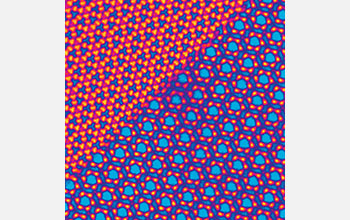Multimedia Gallery
Image from 'Atom Art: Beauty at the Atomic Scale' exhibit
This image shows silicon nitride and highlights how differently atoms can organize in a material depending on how it was manufactured. All silicon nitride is composed of the same atoms, but those atoms can be arranged in very different ways. In this example, the silicon nitride, whose pattern is shown in the upper left, is much harder than the silicon nitride whose pattern is shown in the lower right.
More about this image
The image was created by Jim LeBeau, an associate professor of materials science and engineering at North Carolina State University, and was part of an exhibit he helped curate at the Museum of Life and Science titled " Atom Art: Beauty at the Atomic Scale."
The purpose of the exhibit was to show exactly what microscopy can do at the atomic-scale and explained how atoms are arranged, the patterns that they can make and how this is key to understanding a material's properties and how engineers can control those properties.
LeBeau wanted to show people that "we are now able to actually see atoms and the orderly way that atoms are arranged in a material. The beauty of these patterns highlights just how amazing nature is. Hopefully, we’ll reach young people who may not have otherwise thought about pursuing science."
LeBeau added, "Some of my work is supported by the National Science Foundation and NSF thinks it is important to share our discoveries with the public. I agree. By partnering with the Museum of Life and Science, we are able to help people of all ages understand how we can glean insights into what materials look like at the most fundamental level."
The exhibit ran from Sept. 20 to Nov. 20, 2016.
The research was supported in part by an NSF Faculty Early Career Development (CAREER) award (DMR 13-50273). (Date image taken: 2013; date originally posted to NSF Multimedia Gallery: Jan. 25, 2017)
Credit: James M. LeBeau, Materials Science & Engineering, North Carolina State University
Images and other media in the National Science Foundation Multimedia Gallery are available for use in print and electronic material by NSF employees, members of the media, university staff, teachers and the general public. All media in the gallery are intended for personal, educational and nonprofit/non-commercial use only.
Images credited to the National Science Foundation, a federal agency, are in the public domain. The images were created by employees of the United States Government as part of their official duties or prepared by contractors as "works for hire" for NSF. You may freely use NSF-credited images and, at your discretion, credit NSF with a "Courtesy: National Science Foundation" notation.
Additional information about general usage can be found in Conditions.
Also Available:
Download the high-resolution JPG version of the image. (6.8 MB)
Use your mouse to right-click (Mac users may need to Ctrl-click) the link above and choose the option that will save the file or target to your computer.



